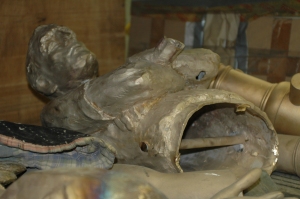| |
Constructing the Full-Scale
Model
My task now was to “blow
up” the sketch to the size of the final sculpture: 48”,
2/3-life size. I spent more than four months, from early
summer into mid fall, 2004, constructing the full-scale
plaster model. This involved building an armature of
pipes and wood and wire mesh which would serve as a
skeleton to support successive layers of plaster. I work
in plaster for my larger sculptures because it hardens
quickly and I like the surface that results when I carve
back into the hard plaster with rasps and knives. I have
to be careful, however, and never let the plaster dry
out. This is never a problem during working hours, since
I am constantly using water to wash away shavings.
However, at night I need to wrap the sculpture in wet
towels and plastic sheeting in order to keep it wet.
Moving from a small
sketch to a much larger model always necessitates
changes. In this case, some of the changes were
substantial and I found the older brother was
particularly difficult. I had to replace his left leg
five times and his head three times! This kind of
surgery is not simple when the sculpture is in plaster.
Each time I changed the leg I had to chip away the
plaster, cut out the wire mesh, and saw through the
armature to remove the offending leg before rebuilding
it. In the final sculpture, the left leg is at a
completely different angle from the leg in the sketch.
In fact, his whole stance is more truculent. (I am
tempted to conclude that this was the result of my
struggle with the figure.) Fortunately the father and
prodigal were more accommodating, and I was able to
finish the plaster model just as the weather began to
turn too cold to work with plaster in the outdoor studio
where I sculpt.
Casting the Bronze
The process of casting in
bronze is very complex and labor-intensive, entailing a
series of molds and casts. Working from the full-scale
plaster model, the foundry fabricates a reusable
latex-and-plaster mold. Next, a replica in wax is cast
from this mold. If the sculpture is large, as in this
case, the wax cast is cut into pieces and each piece
covered with a mold of silica. The silica molds are
fired, turning the silica to ceramic and causing the wax
to evaporate. This is origin of the term “lost wax”. Now
molten bronze is poured into the ceramic molds. The
bronze hardens quickly and the ceramic molds are then
knocked off the bronze.
 |
|
The pieces must then be
welded together and then the reassembled bronze
sandblasted to even out the surface in preparation for
patination. This involves heating the bronze and
spraying it with acids, which turn the metal different
colors. In the case of Reconciliation, I chose a
patina that holds up well outdoors. The bronze is turned
black with acid, scrubbed down to reveal the highlights
of the bronze, and sprayed with layers of acid to turn
it brown. The brown warms the sculpture and softens the
contrast between highlights and shadow areas. A coat of
wax seals the patina and protects it, although this wax
must be reapplied yearly.
Reconciliation
was cast at the New Arts Foundry in Baltimore, Maryland.
I have worked with this foundry for years and they are
generous with their time and expertise, and in their
willingness to allow artist participation. I customarily
visit the foundry to check the wax and sign it, and
return to supervise the patination. I think of these
trips as another instance of collaboration on the way to
the completed sculpture. |
|
![]()